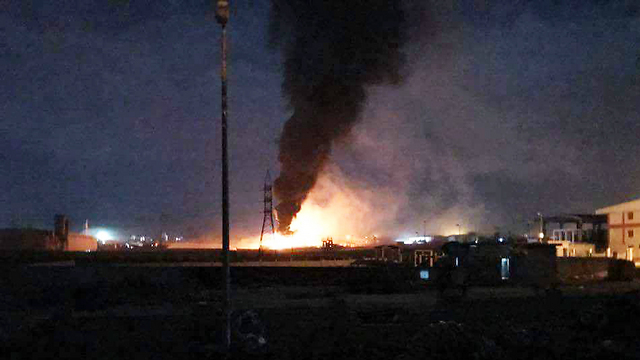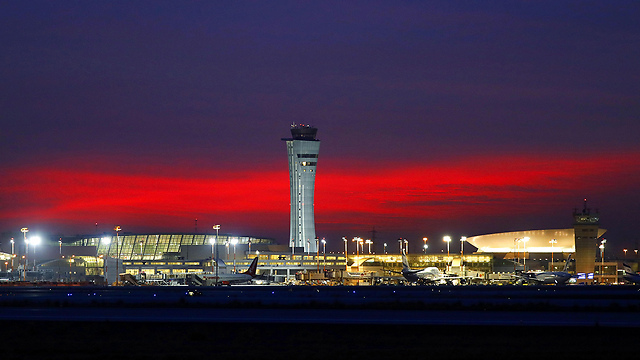
3 possible reasons for the attack on Syria's Jamraya facility
Analysis: The military post allegedly attacked by IAF planes Tuesday night is possibly being used by the Assad regime to develop new types of chemical agents, or by the Iranians to improve the accuracy of Hezbollah-bound missiles and rockets; a third option is that it serves as a station for the transfer of high-quality antiaircraft weapons to Hezbollah.
In this facility, which officially belongs to the Scientific Studies and Research Center (SSRC), the Assad regime is developing and producing—according to foreign reports—chemical weapons and different types of missiles.
Considering the fact that the site has been reportedly attacked at least three times in the past two years with precision-guided weapons—allegedly by Israel, according to the Syrian regime—there are three possible reasons the facility was bombed once again Tuesday night.
One possibility is that Syria is developing new types of chemical agents in the facility. Last week, US media quoted senior Pentagon and State Department officials as saying that Syria was using chemical agents, mainly chlorine, against its own civilians and that it was developing new types of gases to use against the rebels who are still fighting the regime.
These are likely weakened chemical agents that don’t cause immediate death, but neutralize their victims and eventually lead to death after a long period of time. The purpose is to get around the international ban on chemical agents like sulfur mustard and the nerve agent sarin, which were used by the Syrian regime in the civil war in the past.
Israel’s red lines
The United States last week held Russia indirectly accountable for the development and use of these gases in light of its presence in Syria and its protection of a regime that develops such substances. Assuming that the American information is accurate, the development of these chemical agents is likely taking place in the Jamraya facility.
While Israel isn’t confirming or denying the Syrian claims, it has set a number of red lines in the past concerning the northern front that it won’t tolerate or allow. Since the use of chemical agents is one of these red lines, that could be one of the reasons for the alleged Israeli strike.
Another possibility is that the Syrians allowed the Iranians to develop a factory in Jamraya to improve the accuracy of Hezbollah-bound missiles and rockets. According to previous reports, the SSRC facility in Jamraya develops ballistic missiles, making it very likely that the site would also be used by the Iranians for the same goal. Not to mention the fact that the facility is located near the Lebanon border and isn’t far from the road connecting Damascus and the Beqaa Valley and crossing the border.
Foreign sources reported in the past that Israel had attacked a convoy transporting antiaircraft missiles and launchers to Hezbollah in the Jamraya area. It is believed that Hezbollah is constantly trying to obtain modern antiaircraft weapons from Iran and Syria that would limit the Israel Air Force’s ability to operate in Lebanon, mainly SA6 and SA8 mobile missile batteries. At the same time, Iran and Hezbollah are continuing their joint efforts to improve the precision level of the missiles and rockets received by the Lebanese terror organizations or the ones it already possesses.
A third possibility is that the Jamraya facility serves as a station for transferring high-quality antiaircraft weapons or precision-guided missiles from Syria to Hezbollah. At the moment, it’s unclear what exactly was attacked in Jamraya and why, but it’s likely one of these three possibilities.
The Syrians are claiming, for PR purposes, that some of the missiles fired at the Jamraya facility were intercepted, but these claims are—as usual—baseless. Today, aerial or surface precision-guided weapons can be launched from a very long distance—not reachable by the Syrian antiaircraft defense system. If the strike was indeed carried out by Israeli planes, as claimed by the official Syrian media, they likely didn’t operate from Syrian territory but from rather from Israeli or Lebanese territory.
In the not-so-distant past, Syria threatened to target Ben-Gurion Airport if Israel struck in its territory one more time. So far, Syria has failed to act on its threat. The Syrian regime prefers to complain to the United Nations Security Council time and again, but is unable to provide proof that the strikes were carried out by Israel. The UN takes note of these complaints but takes no action, just like it fails to take action in response to the Lebanese government’s repeated claims that Israeli aircraft are infiltrating Lebanon’s airspace.
This time too, Syria likely won’t try to act on its threat, knowing that hitting a sensitive place like Ben-Gurion Airport—or even just trying to do so—would lead to a harsh Israeli response and could even lead to war. In an explicit response to the Syrian threat, Prime Minister Benjamin Netanyahu has said that Israel will hit hard if Syria tries to target Israeli territory.
The last time Israel conveyed such a message to Syria was on Tuesday, when the Political-Security Cabinet’s toured the northern border and was briefed by the IDF chief of staff and senior officers.













